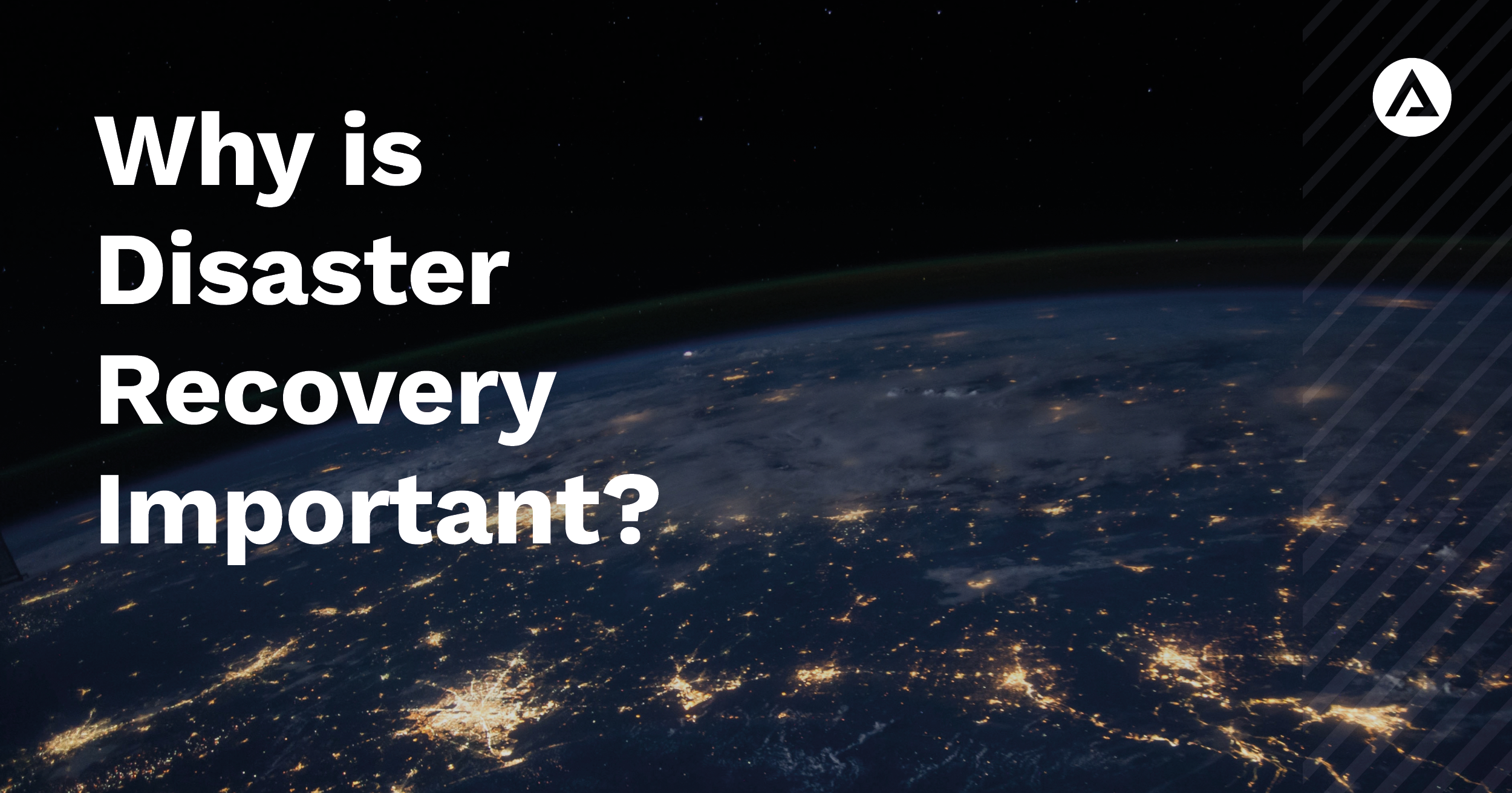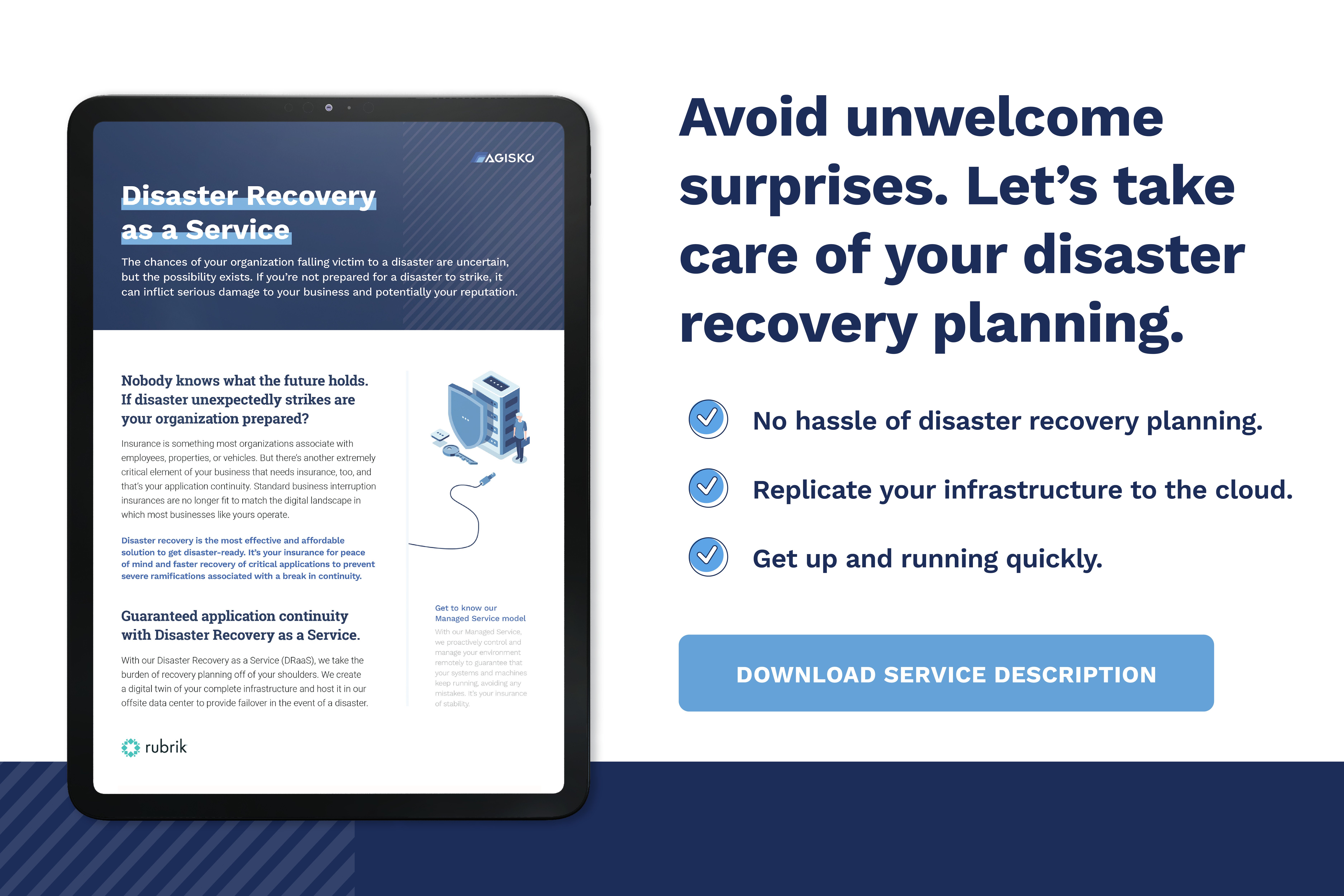An IT disaster is an event that damages computer systems, networks, and processes.
An average disaster costs 4 million euros in damages. Losses like this can sink a business. That's why most organizations affected close within 2 years.
The bad news is, 45% of businesses - and 75% of SMBs - have no disaster recovery plan. They are unlikely to recover after a disaster. And even if they do recover, they're going to lose uptime; money; data.
The good news is, disaster recovery plans and processes can help. With enough preparation, your IT systems will work seamlessly - even through severe disasters.
On this page, we'll explain why IT disaster recovery is important. We'll also look at disaster recovery service types, ways to protect your organization today, and more.

What is Disaster Recovery?
Disaster recovery is the process of restoring IT systems to full operation after an incident. Its main goal is to minimize data loss and maximize uptime.
The best way to do this is by storing and protecting data backups. You can use these backups to restore your IT systems if anything happens to them. If your disaster recovery capabilities are strong, you can do so seamlessly.
Common "disasters" include...
- Natural Disasters
- Physical Damage
- Human Error
- Cyber Attack
- Intentional Misuse
Disaster recovery is part of business continuity. Business continuity is how ready you are to continue IT operations without interruption. Other aspects of business continuity are risk management, oversight, and planning.
5 Reasons Disaster Recovery is Important
1. Less downtime, more uptime
Downtime is when apps, networks, and systems aren't working properly. Downtime is a common outcome of IT disasters - and a big business problem.
Why?
Your business can't work if business-critical apps are offline. Downtime means losing data, money, and goodwill (i.e. reputation). In severe cases, these losses will end your business.
Disaster recovery changes this. It allows you to reduce downtime and maximize uptime at all times; even during a disaster. Your website, servers, apps, etc all work no matter what's going on.
This works because, with data recovery, all IT assets have backups. If anything stops working - a server, a website - the backup is accessed instead.
The backup also means you can't lose your data. Even if the original version is lost to a disaster, you can recover data and restore operations instantly using your backup. This can help save millions of euros in damages on downtime.
2. Data security
Losing one data point costs $160. Customer data, databases, and internal records contain thousands and millions of data points. Losing these can quickly end a business.
Fortunately, your data is safe and sound with disaster recovery. First, because you've always got a backed up version of your data. There's no way to lose this version, especially if it's cloud-based.
Second, data recovery solutions encode and password-protect your data. Other people can't access it, even if they manage to steal it.
This makes your data as secure as can be. You're protected from all disasters, from malicious hackers to basement floods.
3. Your finances are safe
A disaster can cause financial losses in many ways.
Damages from ransomware creators are one example. Losing money to customers suing you because you lost their data is another.
In the worst-case scenario, hackers gain access to your financial data and processes. This can put them in control of your bank accounts and digital payment systems. If this happens, your business is in trouble.
Disaster recovery prevents all these scenarios and keeps your finances safe. Protecting your data and systems stops malicious third parties from harming you financially.
4. Recovery is cheap
Recovering from a disaster can be immensely expensive. You need to replace data and data sets; sometimes alongside the hardware. You also need to create new processes, because your old ones may no longer work.
All of this costs precious time and money.
With a disaster recovery plan in place, everything is different. Your entire IT infrastructure is backed up; it can be restored in seconds. All your old processes and apps can carry on, unaltered.
Disaster recovery processes also reduce the man-hours spent on recovery. Your employees have a plan, so they can get back to work with minimal downtime. This makes recovery fast and cheap.
5. No time lost
IT disasters are time-consuming. Restoring lost data, hardware, and processes can take a while. Sometimes, you have to create new assets from scratch to replace old ones - which is a massive time sink.
This is a problem. While IT systems are down, you can't do business at full strength. Meanwhile, you're losing 8,000+ euros per minute of downtime (on average).
A good disaster recovery plan changes this. By giving you a backup of all your data, it lets you work seamlessly through disasters. Truly advanced solutions can give you over 99% uptime, even if your entire IT system is compromised.
Disaster Recovery Types
Disaster recovery is all about data backup and management. There are 2 main ways to go about it:
Traditional
This is where you keep data on your own hard drives and network. This can be done onsite or offsite.
Storing data onsite has a lot of issues. The main one is that threats to your data, like ransomware attacks or natural disasters, will also stop your backups.
Storing data offsite using encryption, compression, and password protection are better. But sometimes, this isn't enough. Since your backups are on your own assets, some disasters - like a system-wide ransomware or virus attack - could still do you in.
Cloud-based
Cloud-based solutions use a data center-stored mirror of your IT infrastructure. This mirror is isolated from your main IT systems, which makes it safe to use.
Agisko specializes in offering cloud-based disaster recovery as a service (DRaaS). Our solutions keep your data safe, secure, and immediately available during disasters.
An added benefit of working with cloud-based disaster recovery tech? They're 100% hands-off. You just work with your vendor and focus on running your business.
Now let's talk about Agisko's specific approach to DRaaS, which is a little different from other approaches.
How Agisko Handles Disaster Recovery
At Agisko, we create a digital twin of your infrastructure. Our DRaaS plan replicates your apps, computer processing, and networking. We host them in our offsite data center. You’re free to choose which parts of your infrastructure to replicate.
In the event of an outage, your employees can get back to work using the recovery site. They just log into their apps as they would normally do.
We test and track all the elements of your DRaaS infrastructure regularly. Now you don't have to try to resolve faults in the event of a disaster.
Should you delegate disaster recovery to Agisko?
Here are 5 benefits of working with Agisko.
- 360° protection. We back up all your data to our cloud. A comet could wipe out your hard drives; you'd still be safe.
- Pay-as-you-go pricing. No need to pay for equipment, data, or cloud storage you don't need. We only charge for whatever you use.
- Instant recovery. Agisko’s DRaaS clients’ critical apps are restored within 4 hours.
- 100% hands-off. You don't need to set up or plan disaster recovery. Agisko takes care of everything for you.
- It's good business. You can shift from a CapEx financial model to an OpEx one. Say goodbye to heavy investments in secondary data center infrastructure and maintenance costs!
The Bottom Line
If you take a gamble on data security, you could end up losing millions of euros to bad luck.
And yet, actually setting up a data recovery plan (and the processes it needs) is hard. It can also be expensive if you use your own equipment.
That's why Agisko is here to help. We understand that you as a business owner have a million things to do. That's why we offer a hands-off, automated, reliable, cost-effective disaster recovery approach.
We can help you safeguard your data and ensure that your downtime is minimal in the event of a disaster. Check out the link below for more information on our Agisko DRaaS plan.





